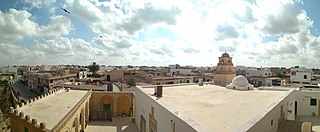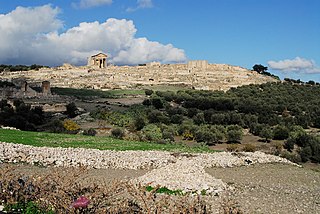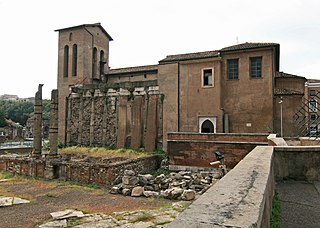
The Roman theatre of Dougga is an ancient theatre (still in use) located in Teboursouk in the north-west of Tunisia.

The Roman theatre of Dougga is an ancient theatre (still in use) located in Teboursouk in the north-west of Tunisia.
Like all the other Roman cities of North Africa from the reign of Augustus, Dougga had its own theatre. According to historians, the monument was built between 168 and 169. It is located in the eastern part of the archeological site Dougga, [1] and can host over 3,500 spectators. [2]
The theatre was classified as a monument on 8 June 1891. [3] It is one of the best-preserved theatres of Roman Africa.
In modern times, it is the site of the annual International festival of Dougga.
A dedication engraved into the pediment of the stage and on the portico the dominates the city, recalls the building's commissioner, P. Marcius Quadratus, who "built [it] for his homeland with his own denarii"; the dedication was celebrated with "scenic representations, distributions of life, a festival, and athletic games".

The Theatre of Pompey, also known by other names, was a structure in Ancient Rome built during the latter part of the Roman Republican era by Pompey the Great. Completed in 55 BC, it was the first permanent theatre to be built in Rome. Its ruins are located at Largo di Torre Argentina.

The Grand Circus Park Historic District contains the 5-acre (2.0 ha) Grand Circus Park in Downtown Detroit, Michigan that connects the theatre district with its financial district. It is bisected by Woodward Avenue, four blocks north of Campus Martius Park, and is roughly bounded by Clifford, John R. and Adams Streets. The district was listed on the National Register of Historic Places in 1983. The building at 25 West Elizabeth Street was added to the district in 2000, and additional structures located within the district, but built between 1932 and 1960, were approved for inclusion in 2012.

El Djem or El Jem is a town in Mahdia Governorate, Tunisia. Its population was 21,544 at the 2014 census. It is home to Roman remains, including the Amphitheatre of El Jem.

Augusta Emerita, also called Emerita Augusta, was a Roman colonia founded in 25 BC in present day Mérida, Spain. The city was founded by Roman Emperor Augustus to resettle Emeriti soldiers from the veteran legions of the Cantabrian Wars, these being Legio V Alaudae, Legio X Gemina, and possibly Legio XX Valeria Victrix. The city, one of the largest in Hispania, was the capital of the Roman province of Lusitania, controlling an area of over 20,000 square kilometres (7,700 sq mi). It had three aqueducts and two fora.

Dougga or Thugga or TBGG was a Berber, Punic and Roman settlement near present-day Téboursouk in northern Tunisia. The current archaeological site covers 65 hectares. UNESCO qualified Dougga as a World Heritage Site in 1997, believing that it represents "the best-preserved Roman small town in North Africa". The site, which lies in the middle of the countryside, has been protected from the encroachment of modern urbanization, in contrast, for example, to Carthage, which has been pillaged and rebuilt on numerous occasions. Dougga's size, its well-preserved monuments and its rich Numidian-Berber, Punic, ancient Roman, and Byzantine history make it exceptional. Amongst the most famous monuments at the site are a Libyco-Punic Mausoleum, the Capitol, the Roman theatre, and the temples of Saturn and of Juno Caelestis.

Musti or Mustis was an ancient city and bishopric in the Roman province of Proconsular Africa, now in northern Tunisia. Its ruins, called Mest Henshir, are about eight miles from Dougga, near Sidi-Abd-Er-Rebbou. It is also a Catholic titular see.

Maktar or Makthar, also known by other names during antiquity, is a town and archaeological site in Siliana Governorate, Tunisia.

A Roman circus was a large open-air venue used mainly for chariot races, although sometimes serving other purposes. It was similar to the ancient Greek hippodrome. Along with theatres and amphitheatres, circuses were one of the main entertainment venues at the time.

Khamissa, ancient Thubursicum Numidarum or Thubursicum, is an Ancient Roman and Byzantine archeological site, in Souk Ahras Province of northeastern Algeria.

Roman Carthage was an important city in ancient Rome, located in modern-day Tunisia. Approximately 100 years after the destruction of Punic Carthage in 146 BC, a new city of the same name was built on the same land by the Romans in the period from 49 to 44 BC. By the 3rd century, Carthage had developed into one of the largest cities of the Roman Empire, with a population of several hundred thousand. It was the center of the Roman province of Africa, which was a major breadbasket of the empire. Carthage briefly became the capital of a usurper, Domitius Alexander, in 308–311. Conquered by the Vandals in 439, Carthage served as the capital of the Vandal Kingdom for a century. Re-conquered by the Eastern Roman Empire in 533–534, it continued to serve as an Eastern Roman regional center, as the seat of the praetorian prefecture of Africa.

The Temple of Janus at the Forum Holitorium was a Roman temple dedicated to the god Janus, located between the Capitoline Hill and the Tiber River near the Circus Flaminius in the southern Campus Martius. The temple was built during the First Punic War, after the Temple of Janus in the Roman Forum.

Barzan is a commune in the Charente-Maritime department in the Nouvelle-Aquitaine region of south-western France.

Rhodiapolis, also known as Rhodia (Ῥοδία) and Rhodiopolis (Ῥοδιόπολις), was a city in ancient Lycia. Today it is located on a hill northwest of the modern town Kumluca in Antalya Province, Turkey.

The Roman Theatre of Mérida is a Roman theatre in the Roman colonia of Emerita Augusta –present-day Mérida, Spain–, capital of the Roman province of Lusitania. Its construction was promoted by the consul Vipsanius Agrippa and was built in 16–15 BCE. It was used for Roman theatrical performances during ancient Rome. Since 1933, it houses the International Festival of Classical Theatre of Mérida.

The Arch of Alexander Severus is a Roman triumphal arch in the ancient civitas of Thugga, located in Dougga, Béja, Tunisia. It was dedicated to the Roman Emperor Alexander Severus.

The Libyco-Punic Mausoleum of Dougga is an ancient mausoleum located in Dougga, Tunisia. It is one of three examples of the royal architecture of Numidia, which is in a good state of preservation and dates to the second century BC. It was restored by the government of French Tunisia between 1908 and 1910.

Victoria Church is an old Roman church located in the city of Beja. It represents the unique Christian monument that has been so far excavated at Dougga.

The Aïn Doura Baths are a series of Roman-era ruins located in Dougga, Tunisia. The site contains ruins from a Roman bath dating to the 4th century, and is considered an important archaeological heritage site by the National Heritage Institute of Tunisia.

The Temple of Juno Caelestis is an archaeological site in Dougga, Tunisia. The ruined temple was dedicated to the Roman goddess Juno, herself an evolution of the Punic goddess Tanit. The temple was built between AD 222 and 235, and is one of the best preserved temples dedicated to Juno in Africa.

The architecture of Tunisia began with the ancient civilizations such as the Carthaginians, Numidians, and Romans. After the 7th century, Islamic architecture developed in the region under a succession of dynasties and empires. In the late 19th century French colonial rule introduced European architecture, and modern architecture became common in the second half of the 20th century. The southern regions of the country are also home to diverse examples of local vernacular architecture used by the Berber (Amazigh) population.